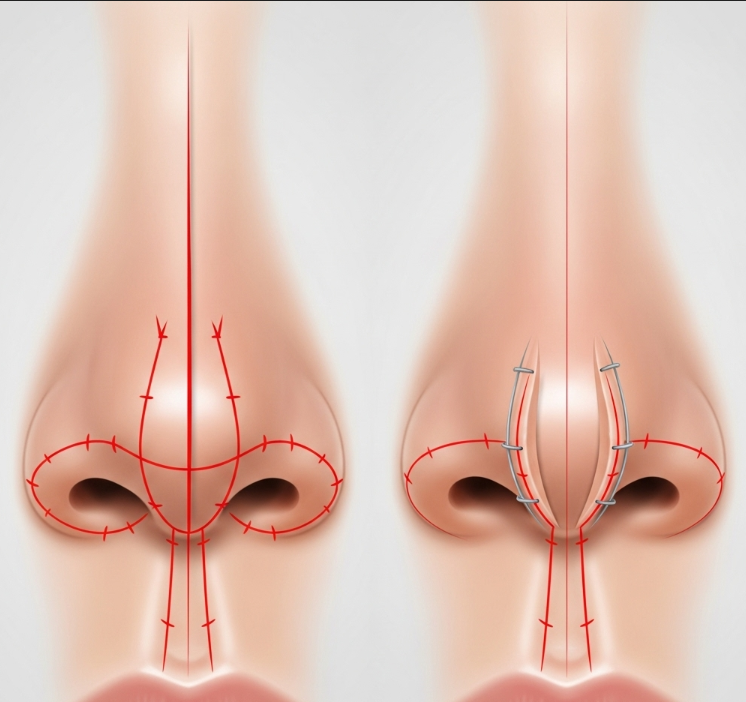Treatment Overview
Revision rhinoplasty, also known as secondary rhinoplasty, is a corrective nose surgery performed after an unsatisfactory or problematic primary rhinoplasty. Unlike first-time procedures, revision surgery is more complex due to scar tissue, altered anatomy, and limited cartilage availability. The goal is to restore both nasal function and appearance, often requiring advanced surgical expertise.
In Korea, revision rhinoplasty is one of the most sought-after procedures, as Korean surgeons are renowned for their precision in correcting prior surgical errors, addressing breathing problems, and achieving natural, harmonious results. Many international patients travel to Seoul for revision cases because of the country’s reputation for artistry and advanced reconstructive techniques.
Purpose & Benefits
The main purpose of revision rhinoplasty is to correct functional or aesthetic issues caused by previous surgeries. Benefits include:
- Restoring normal breathing function (correcting collapsed valves or septal issues).
- Refining nasal aesthetics (improving symmetry, tip definition, or bridge height).
- Correcting over-resection or under-correction from prior surgery.
- Reducing visible irregularities caused by scar tissue or graft warping.
- Achieving more natural and balanced facial harmony.
- Improving patient satisfaction and self-confidence.
Ideal Candidates
Revision Rhinoplasty in Korea is suitable for individuals who:
- Are unhappy with the results of a previous rhinoplasty.
- Experience functional issues such as nasal obstruction or difficulty breathing.
- Have visible irregularities like asymmetry, pinched tip, or crooked bridge.
- Possess realistic expectations about achievable outcomes.
- Are in good overall health and prepared for a potentially longer recovery.
Possible Risks & Complications
Because revision surgery is more complex, potential risks include:
- Increased swelling and longer healing period.
- Breathing difficulties if structural support is compromised.
- Scar tissue complications that limit surgical adjustments.
- Over- or under-correction requiring further procedures.
- Asymmetry or irregular healing.
- Graft-related issues (absorption, warping, or shifting).
Surgical Techniques Used
Korean surgeons use highly advanced reconstructive and aesthetic techniques for revision rhinoplasty, including:
- Cartilage Grafting: Using septal (if available), ear, or rib cartilage to rebuild support.
- Scar Tissue Removal: Carefully releasing or reshaping internal scar tissue for smoother results.
- Tip Reconstruction: Reinforcing and redefining tip structure with grafts or sutures.
- Bridge Correction: Straightening or augmenting the nasal bridge with cartilage or implants.
- Septoplasty/Valve Repair: Correcting functional breathing problems caused by collapsed nasal passages.
- Skin & Soft Tissue Adjustments: Managing thickened skin or scarred areas for improved aesthetics.
Recovery & Aftercare
- Swelling & Bruising: Usually more significant than primary rhinoplasty, improving within 2–4 weeks.
- Splint & Dressings: External splint worn for 1–2 weeks; internal splints may be used for support.
- Downtime: Most patients resume light activities within 10–14 days.
- Final Results: Take longer to stabilize, often 6–12 months due to scar tissue and complexity.
- Aftercare in Korea: Clinics offer scar care treatments, anti-swelling injections, lymphatic massage, and close follow-up.
Results & Longevity
Revision rhinoplasty in Korea typically delivers long-lasting results when performed by skilled surgeons. By rebuilding structural integrity and correcting prior mistakes, patients can expect natural aesthetics and restored function. Outcomes are stable and tailored to the individual’s facial balance, with Korean surgeons emphasizing subtle and refined improvements.
Treatment Process in Korea
1. Consultation
- Surgeons perform CT scans or 3D facial imaging to analyze internal structures.
- Patients discuss concerns and goals; surgeons provide realistic outcome predictions.
2. Pre-Surgery Care
- Comprehensive health check and nasal exam.
- Detailed surgical planning, often including graft source preparation (ear/rib cartilage).
3. Surgery
- Performed under general anesthesia.
- Duration: 3–5 hours depending on complexity.
- Techniques focus on both functional correction and aesthetic refinement.
4. Immediate Post-Surgery Care
- Monitoring in recovery room for several hours.
- Splints and nasal packing applied for stabilization.
5. Follow-Up & Aftercare
- Korean clinics provide advanced aftercare such as LED light therapy, steroid injections for scar control, and swelling management treatments.
- International patients often benefit from medical tourism services (interpreters, airport pickup, recovery support).
Why Korea?
- Global Expertise: Korean surgeons are leaders in revision rhinoplasty, handling some of the most complex cases worldwide.
- State-of-the-Art Clinics: Equipped with advanced imaging, grafting techniques, and scar management systems.
- Medical Tourism Support: Comprehensive care packages for international patients, including translation, accommodation, and transport.
Cost Range
Revision rhinoplasty is more expensive than primary procedures due to complexity and grafting requirements.
- General Price Range: ₩7,000,000 – ₩15,000,000 KRW (approx. $5,600 – $12,000 USD).
- Basic Packages Include: Surgeon’s fee, anesthesia, surgery, and follow-up care.
- Premium Packages May Include:
- VIP recovery rooms
- 3D imaging & surgical simulation
- Rib cartilage harvest (if needed)
- Anti-swelling and scar-control therapies
- Full medical tourism services
Compared to the West, Korea offers highly competitive prices with world-class outcomes, making it a leading destination for revision rhinoplasty.
Popular Clinics
- Banobagi Plastic Surgery (Seoul): Specializes in complex revision cases with natural outcomes.
- ID Hospital (Seoul): Renowned for functional and aesthetic reconstruction in revision rhinoplasty.
- JW Plastic Surgery Clinic: Experts in rib cartilage grafting and difficult revision cases.
- View Plastic Surgery Clinic: Known for comprehensive aftercare programs for international patients.
- MINE Plastic Surgery Clinic: Focuses on scar management and natural refinements in secondary rhinoplasty.




